
Sleep (Physiology 2)
Sleep - Dr Dean Semmens Lecture Outline Welcome to the Sleep & Circadian Rhythms lecture.Rhythms are ubiquitous in the vertebrate central nervous system. They also span a broad range of frequencies, from more than 500Hz in the cortical EEG, to once per year (0.00000003Hz) for many seasonal behaviours, such as swallow migration. In some cases these rhythms are based on intrinsic brain mechanisms, such as which occurs in sleep; whilst others result from environmental factors, such as circadian rhythms. Desired Learning Outcomes By the end of this lecture unit, students should be able to: Understand how electroencephalograms (EEG) signals are generated Identify physiological characteristics of sleep and wakefulness Discuss the neural mechanisms underlying sleep Explain the role of the suprachiasmatic nucleus (SCN) in circadian rhythms Session Resources You can find the full set of PowerPoint slides for the lecture HERE Download HERE. You can find a Kahoot! quiz for the lecture HERELinks to an external site.. Further Reading If you would like to read further or consolidate your knowledge on the topic, I would recommend the following further reading: Neuroscience: Exploring the Brain 3rd or 4th Edition (Bear, Connors, Paradiso) Chapter 19. Any Questions? If you have any questions on the lecture, please feel free to add it to the Padlet discussion board below. Alternatively, please do me email me (dsemmens@sgul.ac.uk) and I'll be very happy to help. I have left some student questions from last year on the Padelt discussion board, just incase this may help with any similar questions that you may have: Made with Padlet Glossary The electroencephalogram – A method of measuring electrical activity in the brain Rapid eye movement (REM) sleep – A kind of sleep that occurs at intervals during the night and is characterised by rapid eye movements, more dreaming and bodily movement, and faster pulse and breathing. Non-REM sleep – A period of sleep characterized by decreased metabolic activity, slowed breathing and heart rate, and the absence of dreaming. Circadian rhythm – The ‘body clock’: a cycle that tells our bodies when to sleep, rise, and eat, regulating many physiological processes Zeitgeber - A rhythmically occurring natural phenomenon which acts as a cue in the regulation of the body's circadian rhythms. Suprachiasmatic nucleus - A pair of small nuclei in the hypothalamus of the brain, above the optic chiasma, thought to be concerned with the regulation of physiological circadian rhythms.
-
What is the significance of brain rhythms? (2)
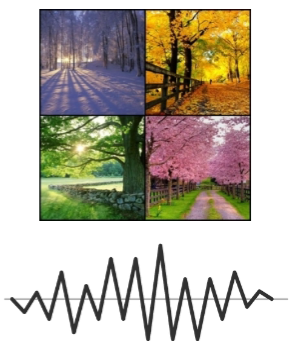
Brain rhythms refer to distinct patterns of neuronal activity.
These patterns are associated with specific behaviours, arousal levels, and sleep states.
-
How do we measure brain rhythmicity? (1)
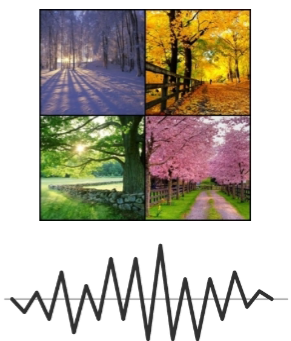
Brain rhythmicity is measured through various systems that monitor rhythmic brain activity, such as EEG.
-
How does the environment affect an animal's behaviour and brain rhythms? (2)
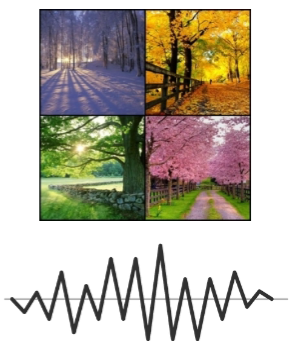
The earth's environment is rhythmic, with variations in temperature, precipitation, and daylight.
To survive effectively, animals must adjust their behaviour and brain rhythms to match these environmental changes.
-
What is the relationship between sleep/wake cycles and brain rhythms? (1)
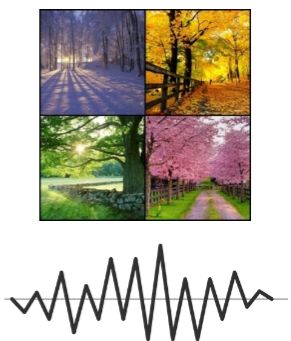
The sleep/wake cycle is one of the most striking examples of how brain rhythms are controlled and synchronized with environmental factors.
-
What is an electroencephalogram (EEG)? (1)
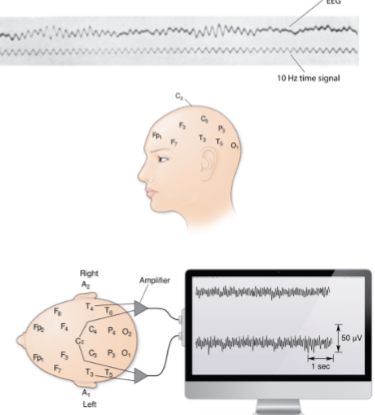
An EEG is a measurement of electrical activity generated by the brain and recorded from the scalp.
-
Who first described the human EEG, and what was its significance? (2)
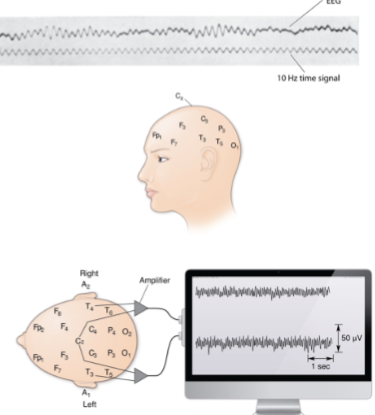
Hans Berger described the first human EEG in 1929.
He showed that waking and sleep EEGs are distinctly different.
-
How is an EEG conducted? (2)
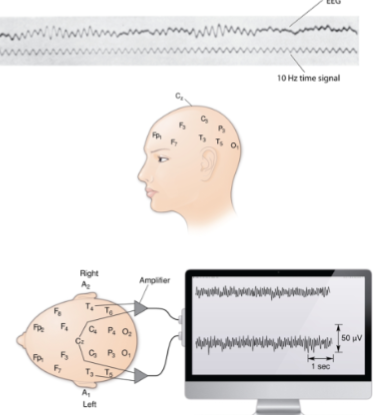
Non-invasive electrodes are placed on standard positions on the head.
These electrodes are connected to amplifiers and a recording device to measure electrical activity.
-
What is the primary use of EEG today? (1)
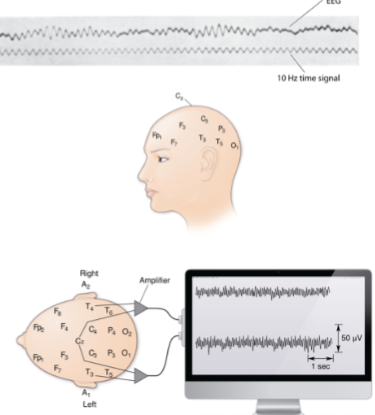
The EEG is primarily used to diagnose certain neurological disorders, such as seizures in epilepsy.
-
What does an EEG measure? (1)
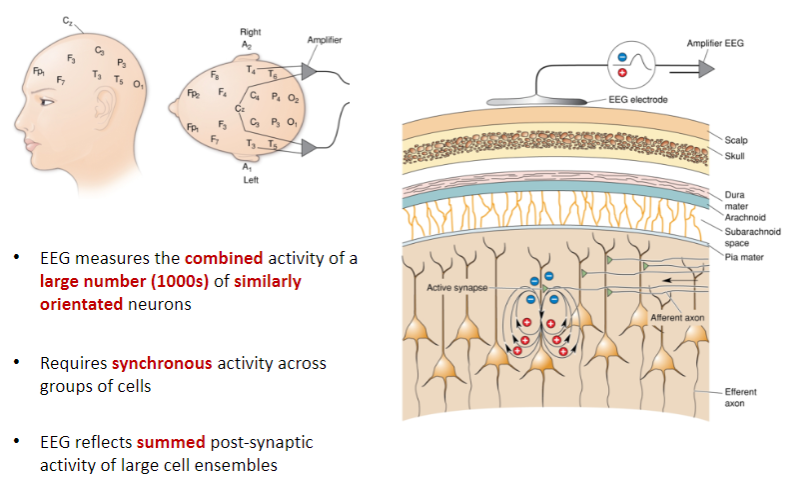
An EEG measures the combined activity of a large number (thousands) of similarly oriented neurons.
-
What is required for EEG measurement? (1)
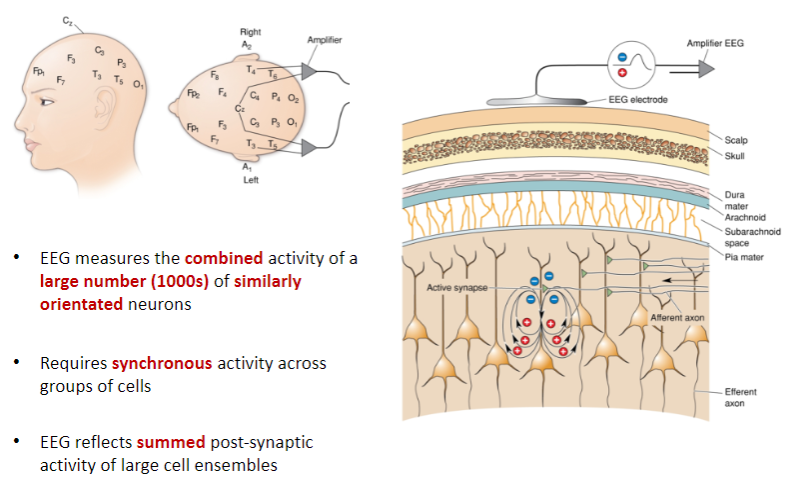
Synchronous activity across groups of cells is required for EEG measurement.
-
What does the EEG reflect? (1)
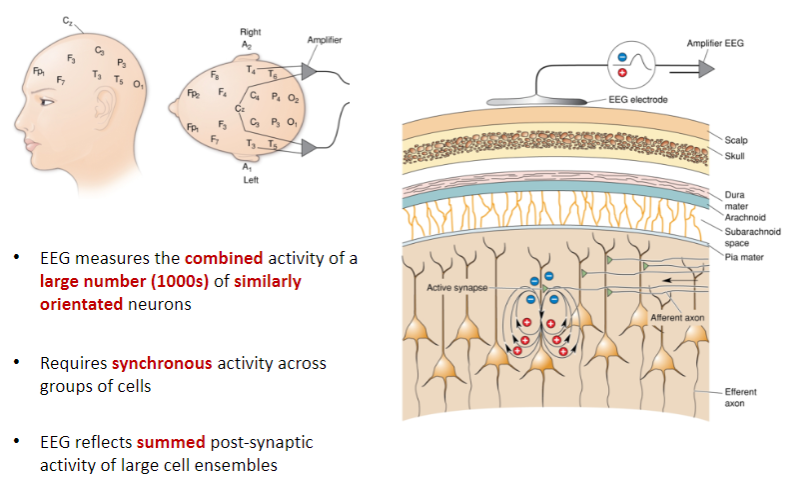
The EEG reflects the summed post-synaptic activity of large cell ensembles.
-
What does the amplitude of an EEG signal depend on? (1)
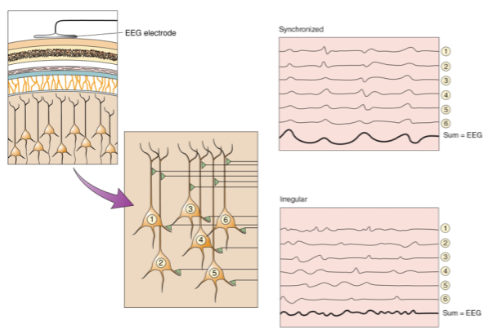
The amplitude of an EEG signal depends on how synchronous the activity of a group of cells is.
-
What happens when a group of cells are excited and synchronous? (1)

When a group of cells are excited and synchronous, the tiny signals sum to generate a large surface signal.
-
How does timing affect the amplitude of an EEG signal? (1)
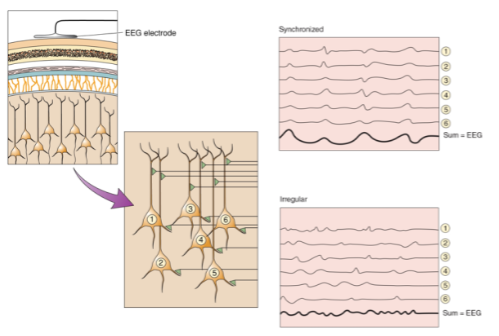
If the same amount of excitation occurs at irregular intervals, it results in a small summed signal.
-
How are EEG rhythms categorized? (1)
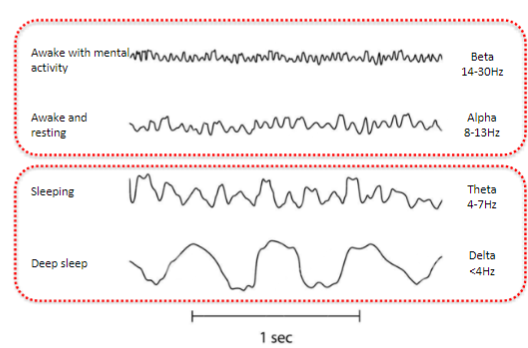
EEG rhythms can be categorized by their frequency range.
-
What type of EEG rhythm is associated with alertness and waking? (1)
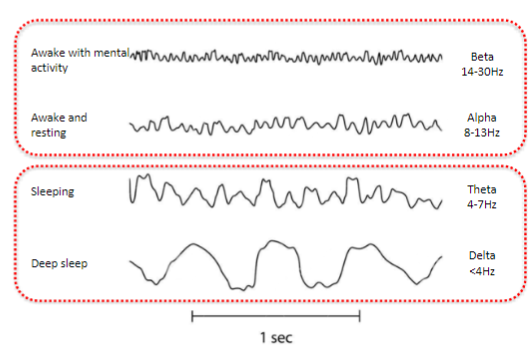
A high-frequency, low-amplitude EEG rhythm is associated with alertness and waking.
-
What type of EEG rhythm is associated with non-dreaming sleep? (1)
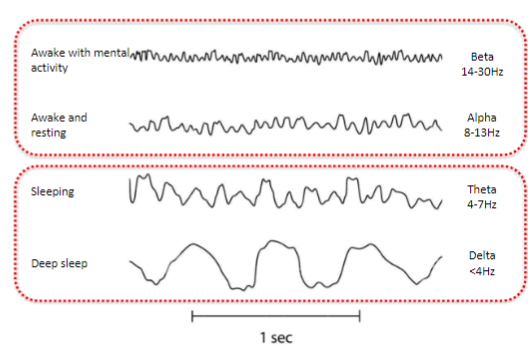
A low-frequency, high-amplitude EEG rhythm is associated with non-dreaming sleep.
-
What leads synchronous brain rhythms? (1)
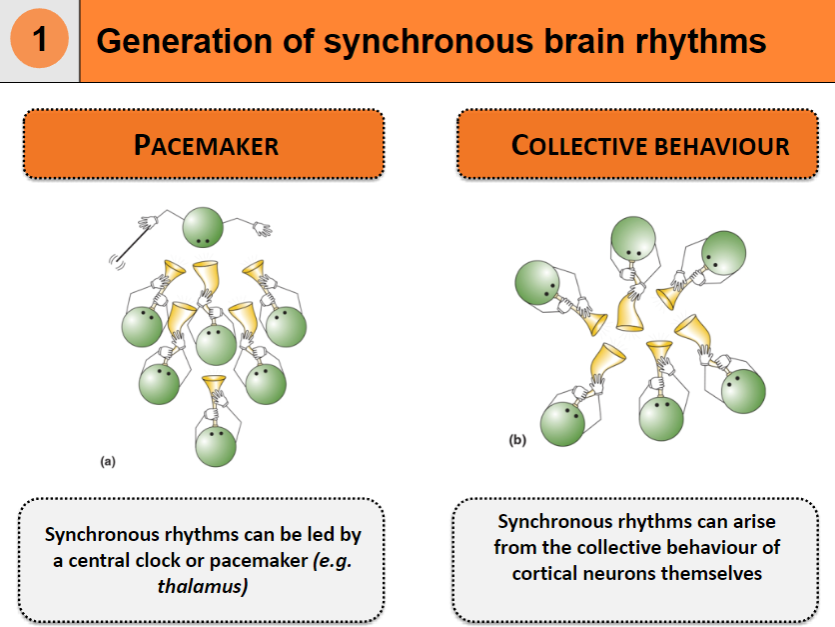
Synchronous rhythms can be led by a central clock or pacemaker, such as the thalamus.
-
How can synchronous rhythms arise in the brain? (1)
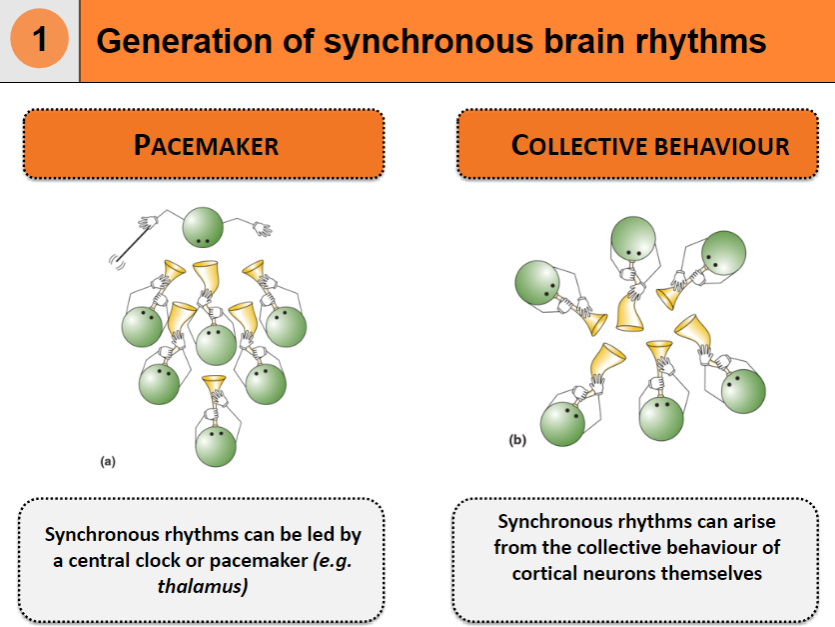
Synchronous rhythms can arise from the collective behavior of cortical neurons themselves.
-
What is the role of the thalamic pacemaker in generating synchronous brain rhythms? (1)
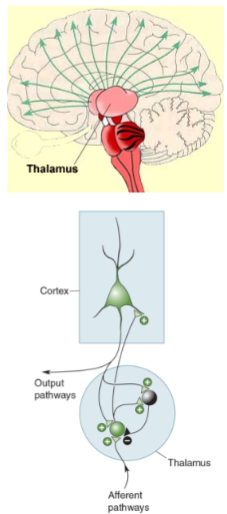
The thalamus acts as a pacemaker by coordinating rhythms and passing them to the cortex via thalamocortical axons.
-
How does the thalamus compel cortical neurons to follow rhythmic patterns? (1)
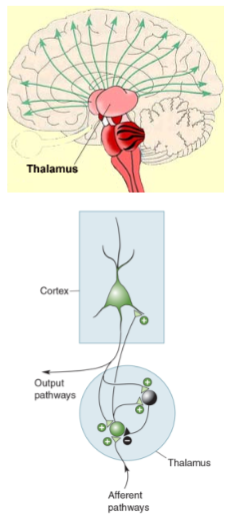
A relatively small group of thalamic neurons can influence a much larger group of cortical neurons, forcing individual neurons to conform to the rhythm through synaptic connections between excitatory and inhibitory thalamic neurons.
-
How do some cerebral cortex rhythms generate synchronous activity without a thalamic pacemaker? (1)
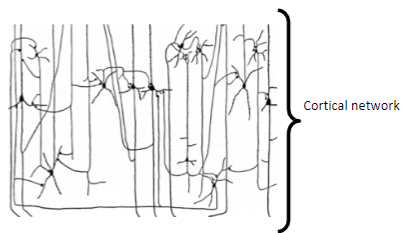
These rhythms rely on the collective interactions of cortical neurons themselves, where excitatory and inhibitory interconnections produce a coordinated, synchronous pattern of activity that can remain localized or spread across larger regions of the cortex.
-
What are the functions of brain rhythms? (3)
Some hypotheses suggest brain rhythms may not have a direct function but instead could be by-products of neural activity.
However, even if they lack a specific function, brain rhythms provide insight into the functional states of the brain, such as in epilepsy.
Brain circuits are strongly interconnected, and the presence of excitatory feedback in these circuits could make rhythmic activity an inevitable consequence.
-
Identify each EEG rhythm:
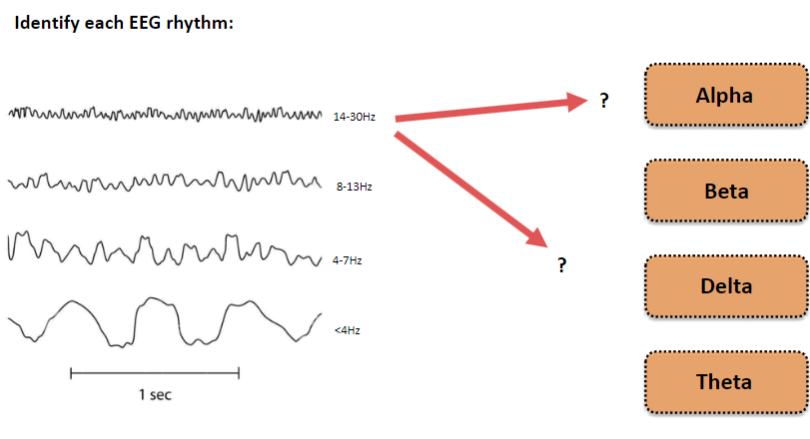
-
What is sleep and do we really need it? (4)
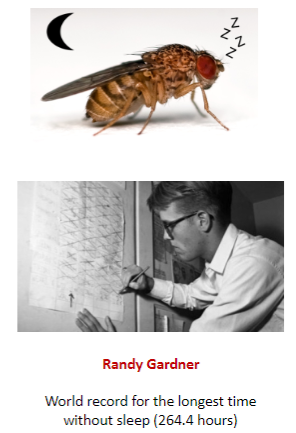
Sleep is a reversible state of reduced responsiveness and interaction with the environment.
Prolonged sleep deprivation can severely impair functioning.
Sleep appears to be universal among animals, including even fruit flies (e.g., Drosophila).
While sleep can be delayed, it cannot be avoided indefinitely.
-
What are the functional states of the brain? (3)
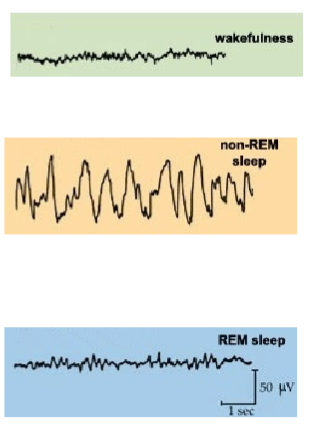
Wakefulness: Active state where the brain processes sensory input and controls body movements.
Non-REM Sleep: Body can move involuntarily, but there are rarely vivid dreams. Described as an "idling brain in a moveable body."
REM Sleep: Body is immobilized, but vivid and detailed dreams occur. Known as "an active, hallucinating brain in a paralysed body."
-
What is the sleep cycle and its stages? (4)
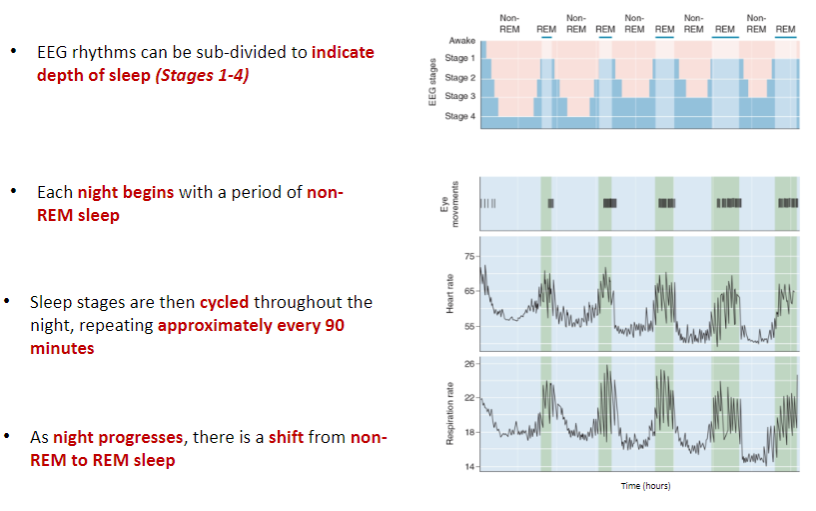
EEG Rhythms: These can be sub-divided to indicate different stages of sleep (Stages 1-4).
Non-REM Sleep: Each night starts with a period of non-REM sleep.
Sleep Cycle: Sleep stages cycle throughout the night, repeating approximately every 90 minutes.
Shift to REM Sleep: As the night progresses, there is a shift from non-REM to REM sleep.
-
What are the differences between Non-REM and REM sleep? (3+3)
Non-REM Sleep:
Brain activity is low ("idling brain in a moveable body")
Temperature, heart rate, and breathing are all decreased
Brain energy consumption is low
REM Sleep:
Brain activity is high ("an active, hallucinating brain in a paralyzed body")
Temperature, heart rate, and breathing are irregular
Brain energy consumption is significantly increased
-
Picture demonstrating A summary table for sleep and wakefulness:

-
What are the two main theories about why we sleep? (2)
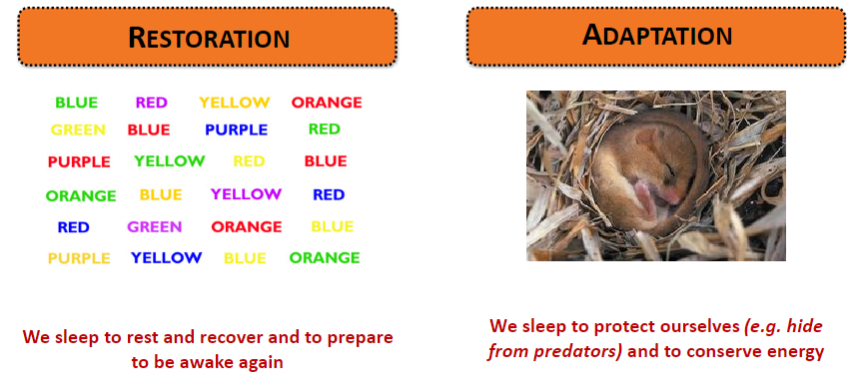
Restoration Theory:
Sleep allows the body and brain to rest, recover, and prepare for wakefulness again.
Adaptation Theory:
Sleep serves to protect us (e.g., hiding from predators) and conserve energy.
-
What increases during wakefulness and which neurotransmitters are involved? (3)
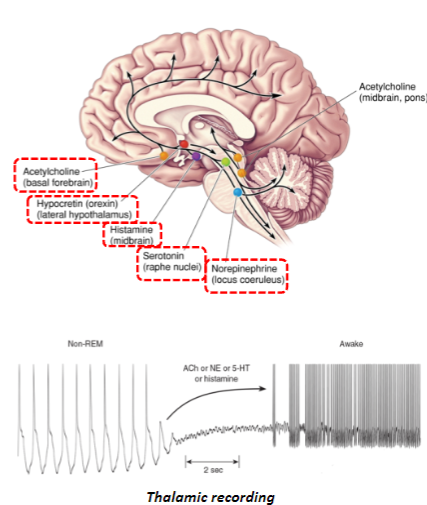
Increased Brainstem Activity:
During wakefulness, brainstem activity increases. Several sets of neurons increase firing rates in anticipation of waking and enhance the wake state.
Neurotransmitters Involved:
Acetylcholine (ACh), serotonin (5-HT), norepinephrine, and histamine are key neurotransmitters that promote wakefulness.
Effects on Thalamus and Cortex:
These neurons synapse directly with brain regions like the thalamus and cerebral cortex. Increased excitatory activity suppresses rhythmic firing patterns seen during sleep in both regions.
-
What happens to brainstem activity during sleep and which neurotransmitters are involved? (4)
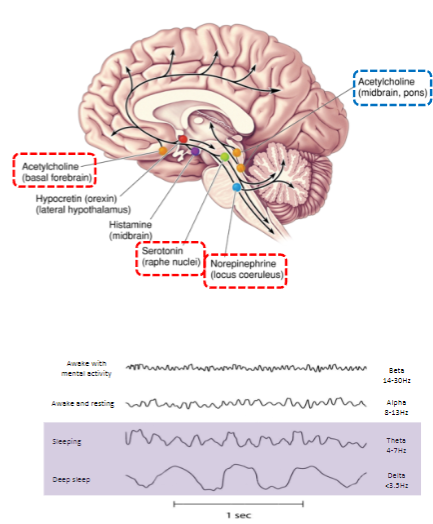
Decreased Brainstem Activity: During sleep, brainstem activity decreases.
Neurotransmitters Involved: Several sets of neurons decrease their firing rate during sleep, including acetylcholine (ACh), serotonin (5-HT), and norepinephrine.
Cholinergic Neurons in Pons: Cholinergic neurons in the pons increase their firing rate to induce REM sleep, which is linked with dreaming.
Thalamus Firing Patterns: Rhythmic firing in the thalamus blocks the flow of sensory information to the cortex, promoting sleep.
-
What is the role of nitric oxide (NO) and adenosine in promoting sleep? (4)
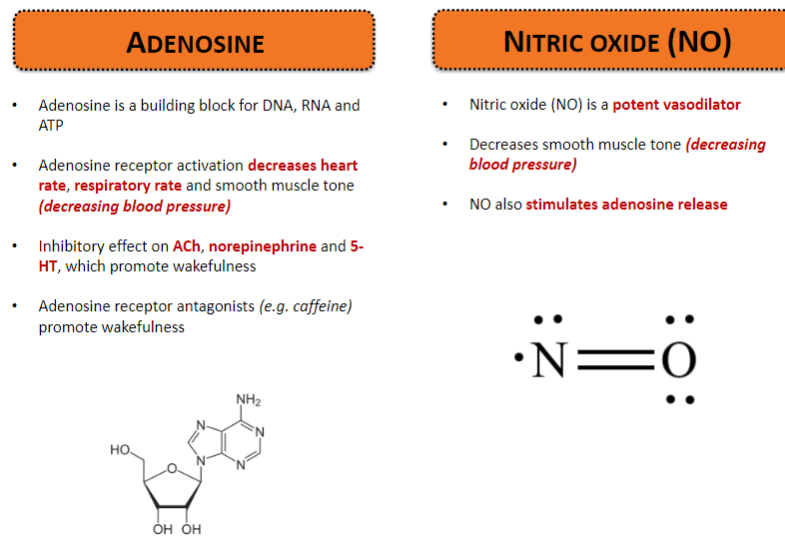
Nitric Oxide (NO): NO is a potent vasodilator, which decreases smooth muscle tone and lowers blood pressure. It also stimulates the release of adenosine.
Adenosine: Adenosine is a building block for DNA, RNA, and ATP. Its receptor activation reduces heart rate, respiratory rate, and smooth muscle tone, lowering blood pressure.
Adenosine's Inhibitory Effects: Adenosine inhibits acetylcholine (ACh), norepinephrine, and serotonin (5-HT), which promote wakefulness.
Adenosine Receptor Antagonists: Compounds like caffeine act as adenosine receptor antagonists and promote wakefulness.
-
What are the roles of melatonin and inflammatory factors in promoting sleep? (4)
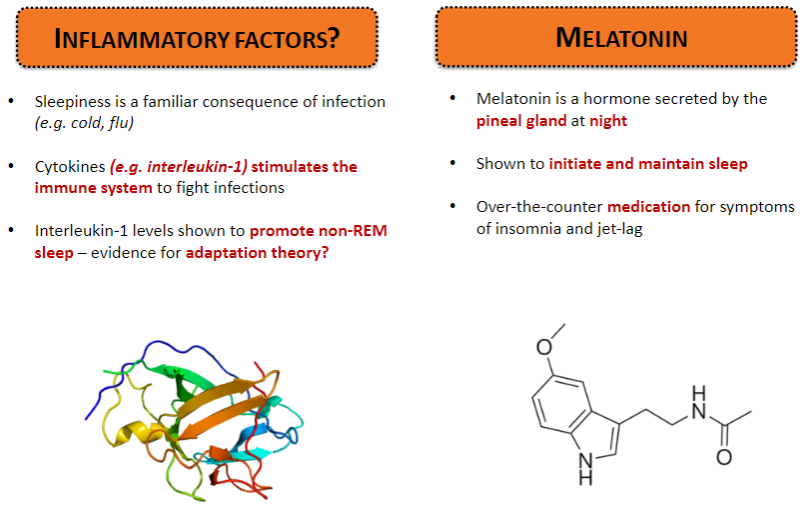
Melatonin: A hormone secreted by the pineal gland at night that helps initiate and maintain sleep. It is commonly used as an over-the-counter medication for insomnia and jet lag.
Inflammatory Factors: Sleepiness is a common symptom of infection (e.g., cold, flu).
Cytokines: Cytokines like interleukin-1 stimulate the immune system to fight infections.
Interleukin-1 and Non-REM Sleep: Elevated levels of interleukin-1 promote non-REM sleep, which may support the adaptation theory of sleep.
-
What are circadian rhythms and how do they function in animals? (4)
Circadian Rhythms: A circadian rhythm refers to any rhythm with a period of approximately 24 hours.
Persistence in the Absence of Light: If cycles of daylight and darkness are removed, circadian rhythms continue to operate in animals.
Coordinated Behaviour: Almost all land animals coordinate their behavior based on circadian rhythms, which are linked to daily cycles of daylight and darkness caused by the Earth's rotation.
Physiological Processes: Most physiological processes, such as temperature and hormone levels, also rise and fall with these daily rhythms.
-
What are zeitgebers and how do they affect circadian rhythms? (4)
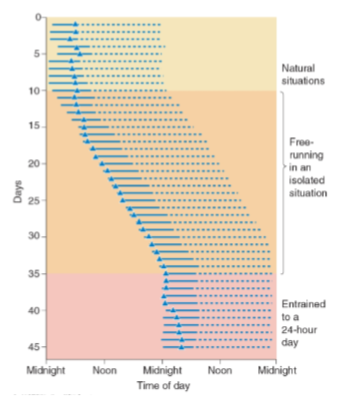
Definition of Zeitgebers: Environmental time cues like light-dark cycles, temperature, and humidity are collectively called zeitgebers.
Difficulty of Separation: It's challenging to completely separate humans from all zeitgebers, even in controlled environments such as laboratories, as factors like people coming and going provide time cues.
Isolation Studies: The most effective studies isolating humans from zeitgebers are conducted in deep caves.
Free-running State: When humans are removed from all zeitgebers, they enter a "free-running" state, where their internal biological clock operates on a cycle of approximately 24.5-25.5 hours.
-
What is the role of the suprachiasmatic nucleus (SCN) in circadian rhythms? (3)
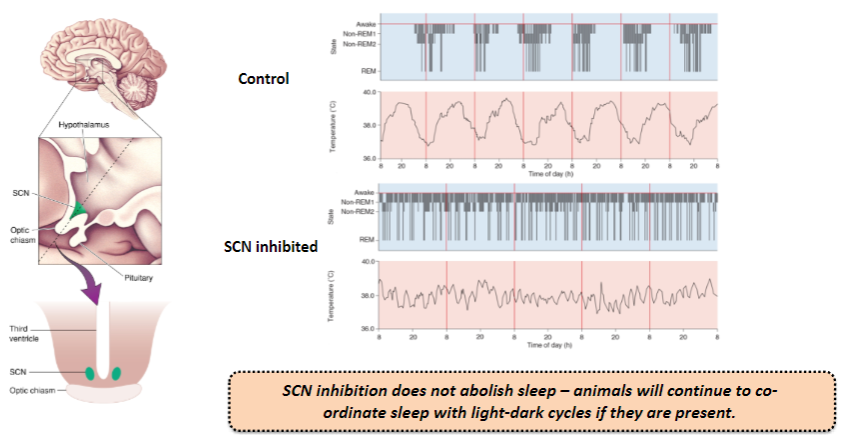
Location and Function: The SCN is a small nucleus in the hypothalamus that synchronizes circadian rhythms with the daily light-dark cycle by receiving retinal innervation.
Role in Sleep Coordination: Inhibition of the SCN does not abolish sleep, as animals will continue to coordinate sleep with light-dark cycles if those cycles are present.
Light-Dark Synchronization: The SCN helps to maintain synchronization between internal biological rhythms and external environmental cues such as light.
-
How do neurons in the SCN regulate circadian rhythmicity? (3)
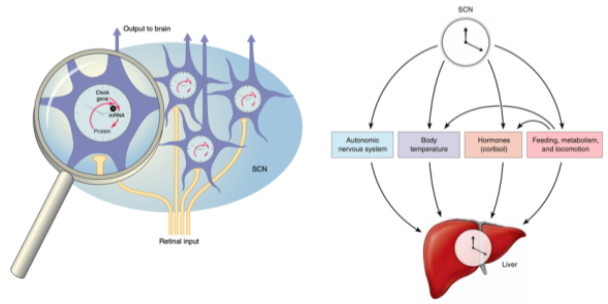
Clock Genes and Feedback: SCN clock genes produce proteins that send feedback to the SCN, inhibiting further production of those proteins. This process happens over a 24-hour cycle.
Role of Light: Light information from the retina serves to reset the SCN neuron clocks each day, ensuring synchronization with the light-dark cycle.
Control of Body Clocks: The SCN controls circadian clocks throughout the body, including in organs like the liver, coordinating the body's overall circadian rhythm.
-
What is the electroencephalogram (EEG)? (2)
A method of measuring electrical activity in the brain.
It records brain wave patterns through electrodes placed on the scalp.
-
What characterizes Rapid Eye Movement (REM) sleep? (3)
Occurs at intervals during the night.
Characterized by rapid eye movements, more dreaming, and bodily movement.
Associated with faster pulse and breathing.
-
What defines Non-REM sleep? (3)
Period of sleep with decreased metabolic activity.
Slowed breathing and heart rate.
Absence of dreaming.
-
What is a circadian rhythm? (3)
The ‘body clock’ regulating sleep, rise, and eating patterns.
Controls many physiological processes.
Operates on a roughly 24-hour cycle.
-
What is a zeitgeber? (2)
A rhythmically occurring natural phenomenon.
Acts as a cue in the regulation of the body's circadian rhythms.
-
What is the Suprachiasmatic nucleus (SCN)? (3)
A pair of small nuclei in the hypothalamus of the brain.
Located above the optic chiasma.
Regulates physiological circadian rhythms in the body.

